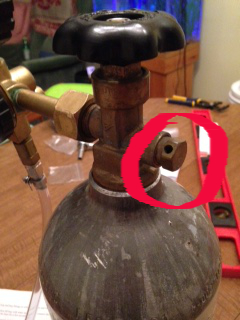TravelingLight
Well-Known Member
I'm kegging my first beer tonight (IPA, if that matters). I'm a big planner so I've got my process all planned out. I was hoping someone more knowledgeable than me can check my process and tell me if all is well or I should adjust anything. Here's my plan...
1. Clean, sanitize, and fill the keg with my syphon, minimizing splashing, seal it up.
2. Turn up the gas to about 10 psi for 20 seconds, then pull the pressure release valve. Do this two or three times to purge the residual oxygen. [**Do I keep the gas hooked up during this and just keep purging and letting it re-pressurize?**]
3. Then put the psi about 10-12, remove the gas line and put it in the kegerator overnight to chill.
4. Next day, crank the gas to 30 psi, roll the keg back and forth for 3-5 minutes. [**Do I keep the gas connected during the rolling or just get it to pressure then remove the gas line before rolling?**]
5. After rolling the keg, remove the gas line (but keep the pressure at 30 psi), and place back in the kegerator for 8-10 hours.
6. Finally, bleed all pressure from the keg, re-attach the gas line and crank it up to serving pressure.
Is this correct? Is it overkill? Thanks for any advice and answers to my above questions as well.
1. Clean, sanitize, and fill the keg with my syphon, minimizing splashing, seal it up.
2. Turn up the gas to about 10 psi for 20 seconds, then pull the pressure release valve. Do this two or three times to purge the residual oxygen. [**Do I keep the gas hooked up during this and just keep purging and letting it re-pressurize?**]
3. Then put the psi about 10-12, remove the gas line and put it in the kegerator overnight to chill.
4. Next day, crank the gas to 30 psi, roll the keg back and forth for 3-5 minutes. [**Do I keep the gas connected during the rolling or just get it to pressure then remove the gas line before rolling?**]
5. After rolling the keg, remove the gas line (but keep the pressure at 30 psi), and place back in the kegerator for 8-10 hours.
6. Finally, bleed all pressure from the keg, re-attach the gas line and crank it up to serving pressure.
Is this correct? Is it overkill? Thanks for any advice and answers to my above questions as well.




 Thanks for the kind words! Unfortunately I'm down to maybe 5-6 bottles of the sour red from last year, so I'd like to hang on to those. I'll be brewing it again in a few months, so if you remember to hit me up around October I'm sure I'll have several bottles
Thanks for the kind words! Unfortunately I'm down to maybe 5-6 bottles of the sour red from last year, so I'd like to hang on to those. I'll be brewing it again in a few months, so if you remember to hit me up around October I'm sure I'll have several bottles 